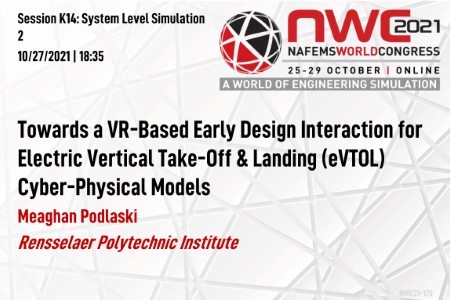
Abstract
In the development of eVTOL systems, simulation-based studies using well-understood physics-based models are extremely valuable to determine which designs best comply with specifications and requirements before manufacturing them. It’s difficult to integrate human interaction in early design stages into the engineering design process, for both designer and end-user, because typical engineering requirements don’t depend on human factors. This opens the research questions: (1)can the design improve if designers interact with the virtual prototype during early design phases?, and (2)can the end-user interaction at early phases fulfill unperceived end-user needs and requirements w.r.t. existing approaches? To address such questions, a “virtual design” environment is needed allowing for designers/end-users to interact with the “virtual prototypes”. This paper discusses preliminary work to address how virtual reality-based technologies can enable interaction with eVTOL models early in the design process, providing more flexibility to study models with additional human feedback. The proposed systems engineering method can also provide a basis for a eVTOL virtual reality-based flight training simulator.
The proposed method is implemented for a multi-domain drone model created using the open access standardized modeling language, Modelica. This paper builds off the model described in [1] to show methods to simulate and interact with the drone using virtual reality. The drone model is instrumented with additional functionalities from a visualization library [2], coupled to a generic gaming flight controller, and interfaced with a custom off-the-shelf headset. The model is exported to a gaming environment using the Functional Mock-up Interface (FMI) open access standard. The FMI allows exporting models as functional mock-up units (FMUs) [3] to use them in other environments through a standardized software interface. This allows us to deploy the models to take advantage of the VR ecosystem provided by game engines. The results aim to highlight the importance of the use of open access and open source model exchange standards, specifically FMI, for model portability into new interaction environments that weren’t initially conceived for simulation purposes.
[1] Vanfretti, L., Nademi, H., Podlaski, M., and Chang, H., “UAV Dynamics and Electric Power System Modeling and Visualization using Modelica and FMI,” , 10 2020.
[2] Hellerer, M., Bellmann, T., and Schlegel, F., “The DLR Visualization Library - Recent development and applications,”Link̈oping Electronic Conference Proceedings, The 10th International Modelica Conference 2014, March 2014
[3] “FMI Standard,” https://fmi-standard.org/, March 2021.



